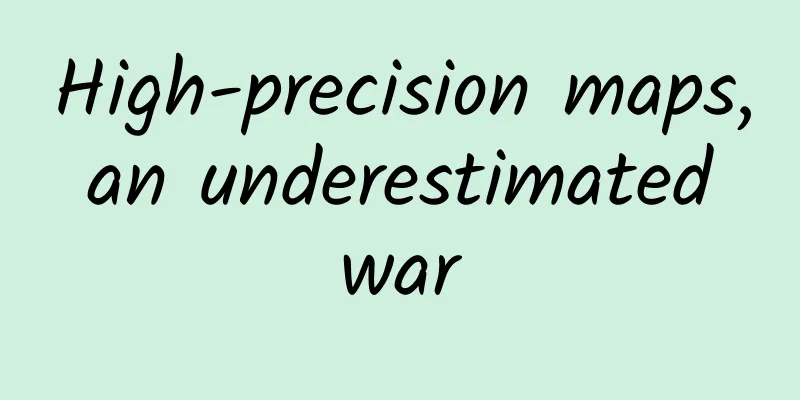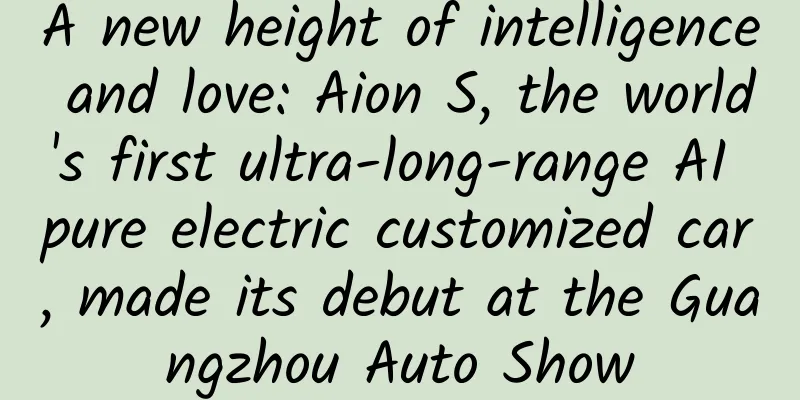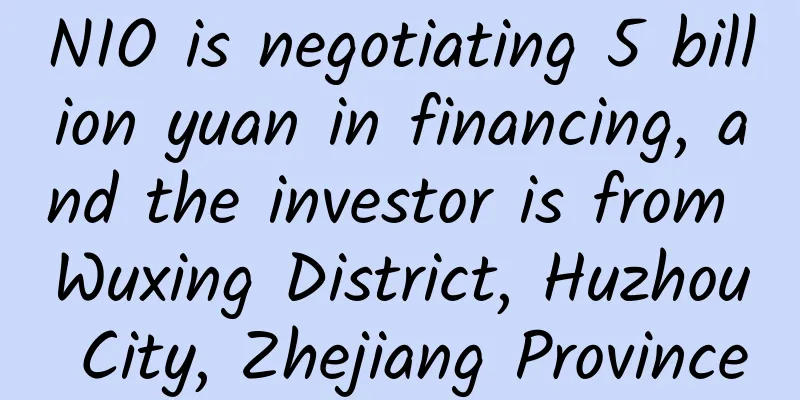High-precision maps, an underestimated war

|
In historical confrontations, many famous battles have taken place between BAT: e-commerce, payment, O2O, AI... and maps have always been a war that has been underestimated by public opinion. In the three years from 2011 to 2014, the traditional map manufacturers experienced an unexpected reshuffle of fate. With the advent of the mobile Internet, Internet giants have set their sights on the battlefield of electronic navigation maps. Giants have crossed borders to subvert and "take over the mountains and rivers", and map vendors have been "adopted" one after another - Baidu took the lead and launched the mobile version of Baidu Maps in April 2011. In 2013, it played the "permanent free" card full of "Internet thinking" and occupied the top spot in mobile navigation. In 2013, it acquired the map vendor Daodaotong (Changdi Wanfang); Alibaba acquired AutoNavi in April 2014; only one month later, Tencent invested 1.17 billion yuan in NavInfo and acquired Keling Hangrui in the same year. But it was also in 2014 when the "map vendors were being sponsored" that a new technology that has influenced today's map industry was taking shape. That is the "high-precision map" that emerged with autonomous driving and vehicle networking technology. Just seven months after being acquired, AutoNavi began cooperating with Shanghai GM on high-precision maps in November 2014, becoming one of the earliest players in China to deploy high-precision maps. In the new wave of technology and commercialization of autonomous driving and vehicle networking, the status of high-precision maps has been greatly improved compared with navigation maps in the mobile Internet era: Because electronic navigation maps are just the icing on the cake in the era of mobile travel, while high-precision maps are an indispensable infrastructure in the era of autonomous driving. Therefore, as a number of exciting new concepts such as AI, 5G, Internet of Things, Internet of Vehicles, autonomous driving, and smart travel have appeared one after another, high-precision maps, an industry overshadowed by the halo of autonomous driving, has launched a more complex war. The tension first manifested itself in the venture capital market. In February this year, Kuandeng Technology, which was founded only a year ago by Liu Jun, the former chairman of Baidu Takeout, received several hundred million yuan in Series A financing from institutions such as IDG Capital; five months later, wayz.ai, founded by Tao Chuang, the former head of Microsoft Maps, also received US$80 million in Series A investment; last year, Ji'ao Technology, a high-precision map startup with former members of NavInfo as its main founding team, received tens of millions of yuan in investment from institutions such as SoftBank China in March and at the end of the year - judging from the amount of financing, the high-precision map track has been close to the same round of financing as some L4 autonomous driving companies. Looking at the overall situation, it is not just start-ups that are eyeing this track: in addition to start-ups, new players also include small giants such as Didi, JD.com, and Meituan that control the scenarios, as well as OEMs that are customers in the map industry; the old-timers include the upstream map vendors such as AutoNavi and NavInfo, and BAT, which stands behind the map vendors and has previously invested heavily in the map industry. If you search for "high-precision map engineer" on recruitment websites, you will find more meaningful results: Some new energy vehicle companies, autonomous driving companies, and autonomous driving chip companies are also recruiting high-precision map-related talents. Are high-precision maps a revival of the traditional mapping industry or a new era of land enclosure movement? High-precision maps: a game-changer in the map industry At the end of August 2013, many journalists covering the "mobile Internet" field received invitations to a press conference from AutoNavi, with the theme of "change". Established around 2000, AutoNavi and NavInfo, among other old map vendors, previously focused on the B2B business of electronic car navigation maps and PC maps, with clients such as BMW, Mercedes-Benz, Baidu, and Sina. The map and Internet circles once kept to themselves. After 2009, the wave of mobileization gradually emerged, and AutoNavi entered the mobile navigation map market, starting to transform from a "silently making money" to a well-known to C company. This press conference with the theme of "change" is to announce this transformation more thoroughly. But just one day before the press conference, what AutoNavi did not expect was that Baidu, then AutoNavi's biggest competitor in the mobile navigation map market, announced that it would "change" and become permanently free. AutoNavi had to follow suit that evening: the AutoNavi Navigation App, which originally cost 50 yuan, could be downloaded for free from now on. At the press conference the next day, AutoNavi's then-CEO Cheng Congwu could not hide his dissatisfaction. He said: "Baidu is an Internet company and should not charge any fees" and "Its navigation is unprofessional." However, just eight months later, AutoNavi, which was suffering huge losses, was sold to another Internet giant, Alibaba. When AutoNavi was sold, Baidu Maps, which had been online for only three years, had already captured 66.3% of the mobile navigation market and had 200 million users; AutoNavi's operating profit fell to -193%, with a loss of US$46 million in the first quarter of 2014; it was also in that year that Tencent invested in NavInfo and acquired Kelvin Maps; and Baidu acquired map provider Daodaotong the year before. A map industry practitioner said: "(Maps) were originally upstream of the Internet, but now they are being taken care of by the Internet." The turmoil before and after the press conference and what happened to AutoNavi later on were a microcosm of the impact of the "mobile Internet" wave on the map industry at the time: mobile navigation maps impacted the traditional electronic navigation map market with faster networking and update speeds, better user experience, a direct to C business model and a free strategy. After the "free" battle of electronic navigation maps, mobile navigation apps have become widely popular. Their functions actually partially cover the functions of in-car navigation maps. The business model of map vendors who used to charge money from car manufacturers has been impacted. However, making maps is a high-cost and high-investment industry, which directly deprived map vendors of their profits. Now, just a few years after the fate of the last electronic navigation map was reshuffled, high-precision maps, which have entered the commercialization process, are once again rewriting the map industry. In terms of mapping technology, functions and position in the industrial chain, high-precision maps are significantly different from previous electronic navigation maps. Ding Fei, investment director of IDG Capital, said that high-precision maps mainly bring three variables to the industry: crowdsourcing, artificial intelligence and the urgent need for autonomous driving. Crowdsourcing means lower costs, artificial intelligence means higher efficiency, and rigid demand means stronger willingness to pay. The map production process can be roughly divided into field work and indoor work. Field work includes collecting original data, while indoor work involves the subsequent filling in of gaps, proofreading, annotation and processing of data. Crowdsourcing has changed the way data is collected, that is, "field work". As high-precision maps require a high frequency of updates, the past practice of building a professional team to collect data could not keep up with the update progress. The industry generally believes that crowdsourcing will become the ultimate collection mode for high-precision maps, and its direct benefit is to reduce the collection cost. Artificial intelligence improves the efficiency of internal work: when processing data in the later stage, computer vision and machine learning can increase the degree of automation of data processing, thereby reducing manpower expenses and greatly improving the speed of mapping. Cai Rui, founder of high-precision map company DeepMotion, believes that DeepMotion has already achieved 90% automation in urban road data processing. "In the future, we hope to achieve 100% automation," said Cai Rui. Wang Xuekun, CTO of another high-precision map company, Ji'ao Technology, summarized the current efficiency improvement in high-precision map making: "I use outsourcing to replace field work; I use artificial intelligence to replace internal work; I use an automated map platform to replace the original production." The benefit of "urgent need" is that the market expands and the willingness to pay increases. In travel and daily life scenarios, electronic navigation maps are not actually a necessity, but in autonomous driving and smart travel scenarios, high-precision maps are the basic safety guarantee that "saves lives". Therefore, car manufacturers and operators who want to do Robot Taxi (a shared travel service composed entirely of autonomous driving vehicles) in the future have a strong willingness to pay. An investor who focuses on the field of autonomous driving believes that "HD map technology can expand the entire Chinese map market by four to five times in at least three to four years." There are roughly three kinds of positioning facing various groups, either openly or covertly: 1. Bottom layer: being an upstream map supplier that sells licenses and related operation and maintenance services, which was the main business model of NavInfo and AutoNavi in the past; 2. Middle layer: "Solution providers" that provide services for travel, logistics and other scenarios, such as the current business forms of Baidu Maps and Amap's open platforms; 3. Upper layer - connect to the end and become an application provider yourself, such as the "Robot Taxi" operator which is generally optimistic about the huge potential, similar to the current Didi model. When different people see the same plate of meat, they think of different dishes. Veteran map vendors: revival The first to take the lead were established map vendors. For them, high-precision maps are an opportunity for "revival". Previously, map vendors had an experience of "the duck in the mouth flew away": around 2010, the in-car navigation map market took off, and the few remaining big players such as AutoNavi and NavInfo were considered to have reached the stage of reaping the benefits of oligopoly. However, map apps suddenly emerged at this time, and the in-car navigation market stagnated. The map vendors' years of investment did not get the expected return. On the other hand, map manufacturers have lost to the Internet when "hunting new ducks". Map vendors have not failed to see the new trend of mobileization. In 2009, AutoNavi was the first to launch a map application on the Apple App Store, becoming the first Chinese company to produce a mobile navigation map app, two years earlier than Baidu. Also in 2009, AutoNavi's old rival in the in-car navigation market, NavInfo, began to cooperate with Nokia and pre-installed navigation functions on Nokia's mobile phones at the time. But in the end, the map vendors who saw the opportunity did not seize it and lost to Baidu Maps, which shifted from PC to mobile. After all, mobile navigation apps are ultimately consumer Internet logic for consumers. Compared with AutoNavi, which was priced at 141 yuan when it first went online, Baidu did not intend to make money from maps from the beginning, but to be a traffic entrance, and unswervingly expanded its scale rapidly with low prices and free models. As mentioned above, high-precision maps bring three variables: crowdsourcing to reduce costs, AI to improve efficiency, and rigid demand. This has greatly increased the profit margin of the to B automotive map route that map vendors are already very familiar with, and to B has once again become a promising path. Old-fashioned map vendors who have been dealing with car manufacturers for more than ten years have the advantage of "being close to the water and getting the moon first" and have the advantage of eating this cake. Among the old map vendors, Amap is the fastest to act. A map industry practitioner said that in 2015, AutoNavi went to a university laboratory in southern China to see the imported surveying and mapping vehicles. At that time, the price of a vehicle was close to 10 million yuan. AutoNavi experienced it for two months and decided to place an order to buy it. Not long ago, Wei Dong, president of AutoNavi's automotive business unit, also revealed at the "Automotive New Ecology Forum" that AutoNavi purchased a fleet of 5 or 6 surveying vehicles costing 8 million yuan in 2015, which mapped 300,000 kilometers of highways across the country. On May 22 this year, another major map provider, NavInfo, teamed up with European map provider Here (which was acquired by the "German Auto Alliance" consisting of Daimler, BMW and Audi for US$3.2 billion in 2015), Japanese high-precision map provider IPC, and South Korea's largest communications operator SK Telecom to establish the OneMap Alliance, planning to jointly establish global standards for high-precision maps. Yitutong, which shares the market share of in-vehicle navigation maps with AutoNavi and NavInfo, also announced that it will focus on high-precision maps in the future. Yitutong has established its own automated production line for high-precision maps. Wang Zhigang, chairman of Yitutong, said that their consideration is that it is better to be in the right place than to be early: I want to figure out when the market will arrive. If I am not ready when the market arrives, then I will lose. But if the market gives me time, why should I do it early? " Yitutong's logic is that within the window period, the later you start, the cheaper the equipment, the more accurate the specifications, and the higher the production efficiency. "Whether from the perspective of equipment cost and production efficiency, quality control, and the effectiveness of specifications, it is the smartest strategy to delay as much as possible without losing market opportunities, right?" Wang Zhigang said. Judging from the current "results", AutoNavi is temporarily leading in the route to car manufacturers. AutoNavi has taken the lead in winning the mass production order of high-precision maps: In June 2018, AutoNavi announced that it would provide high-precision map data and subsequent technical upgrades and cloud update services for GM's Cadillac CT6 40T Platinum Edition equipped with Super CruiseTM. Currently, the market believes that Super CruiseTM is at the L2.5 level. However, a map industry practitioner revealed to "Jia Zi Guang Nian" that, as far as he knows, the Cadillac order that AutoNavi received "sells one license for 2,000 yuan, totaling 10,000 vehicles, with a total revenue of only 20 million yuan, but it costs hundreds of millions to make this map; and the map produced will only be used by GM at that time, and cannot be used for future L3 level autonomous driving. However, being able to win orders from large automakers also reflects some of AutoNavi's strength. Several industry insiders who have dealt with automakers told "Jia Zi Guang Nian" that, in general, automakers are relatively conservative in their attitude towards cooperation. Before they understand what benefits they will get, they will not easily open up data and resources. AutoNavi has built up a certain amount of trust through its long-term contact with GM. As early as 2005, AutoNavi began to provide navigation map services to Shanghai GM; in November 2014, AutoNavi began to cooperate with GM in the commercial development of high-precision maps. But in the long run, will AutoNavi be content to be a map supplier? Should we believe Wei Dong's resolute statement at the end of last year? He said at the time: "Car manufacturers trust us because we have a principle: whether it is Alibaba or AutoNavi, we will never build cars." But what he didn't say is that there is a general expectation in the industry: when high-level autonomous driving is truly implemented in the future, its application will be in the form of "Robot Taxi". By then, buying and driving a car will become a niche demand, and car manufacturers may become the first-tier supplier of Robot Taxi. In other words, car manufacturing itself may not be the most advantageous and influential link in the future. This hidden "long-term worry" may be one of the reasons why car manufacturers are now developing both autonomous driving and high-precision maps - car manufacturers also want to play the role of operators. In the field of high-precision maps, in addition to cooperating with map vendors, some OEMs have already made their own arrangements: During the 2017 National People's Congress, Geely Chairman Li Shufu submitted a proposal on "Carefully liberalizing map precision surveying and lowering barriers to the development of autonomous driving technology", calling on the government to grant some car manufacturers map surveying qualifications. In the same year, SAIC Group acquired a map vendor called Zhonghaiting and claimed that its technology had reached the L4 level. At a stage when all players in this industry are looking for new roles, AutoNavi may also have similar plans based on maps - to become an operator. In March this year, AutoNavi tried the ride-sharing business, and announced that it would be "free of charge for both passengers and drivers" and "never charge commissions". Backed by Alibaba, AutoNavi seems to have the idea and strength to enter the downstream application layer and do "shared travel". One of the imagination spaces in the high-precision map industry is whether anyone can start from maps and eventually become a Robot Taxi operator? Amap is a “seed player” worthy of attention on this path. Other motivations: service providers, data, platforms In addition to the established map vendors and OEMs, other players who enter the market from different angles each have their own "stories". If the established map vendors are good at making traditional dishes, these players with new ideas have created "creative cuisine". There are three typical "new dishes": one is to provide services, the second is to do data, and the third is to build a platform. In the first path, the startup company Ji'ao Technology is a representative. It aims to develop more functions and services for autonomous driving or other industries such as logistics based on high-precision maps, and become a map service provider in the large "smart travel" market; in the second path, there are Didi, JD.com, Meituan and others that have already occupied the "application layer". They have begun to deploy high-precision maps due to their requirements for map data autonomy. Even if these data are not monetized in the future, they can play a key supporting role in the business of Didi, JD.com and other companies; on the third path, the most prominent one at present is Baidu: only Baidu dares to declare loudly that it will build the Apollo platform into the "Android" of autonomous driving, and high-precision maps will be an important part of this platform. Wang Xuekun, co-founder and CTO of Ji'ao Technology, worked at NavInfo for many years. When Jiazi Guangnian mentioned that Ji'ao was a new map provider, Wang Xuekun said, "No, we are a map service provider." Wang Xuekun believes that map vendors are responsible for map production and underlying map technology, while map service providers need to be the "middle layer" and build various map-based capabilities to directly serve scenarios: "Maps are our foundation, and map services are the core. What we export to the outside world is the overall service including maps." According to this logic, high-precision maps do not have to serve the autonomous driving industry, but can also "empower" other industries. "Our goal is to package all kinds of complex geographic information-based services into plug-and-play SDKs and APIs, so that various industries can quickly use high-precision maps. For example, in the logistics industry, the current maps lack information on height limits, weight limits, width limits, truck restrictions, and special lanes, which affects the efficiency of logistics system scheduling, prediction, and dispatching. Express delivery is sometimes blocked, slow, or delivered to the wrong place. This is the reason. Logistics companies don't understand maps and technology, and of course I don't understand logistics, so we package the map capabilities needed by logistics into middleware and provide these companies with map capabilities." Wang Xuekun said. Correspondingly, Ji'ao Technology's current partners include not only car manufacturers, but also shared travel companies and logistics companies. Players who choose the second path value the fact that high-precision maps will accumulate a large amount of social location data in the future. An entrepreneur in the map industry gave an example: the digital camera was invented by Kodak, but the one that made the most money from digital cameras was Instagram because Instagram had accumulated data. The consensus among many interviewees is that the high-precision map industry will form an oligopoly market similar to the navigation map industry in the future: because the cost of making maps is extremely high, the number of companies is naturally limited, so there will not be too many players; but it is difficult for a single company to cover various scenarios such as passenger travel, logistics, and the needs of various car manufacturers and shared travel companies, so it is also difficult to monopolize. But even in an oligopoly of 2 or 3 players, the amount of data that each player can accumulate is staggering. As for how to monetize this data, one idea is to provide LBS services, such as precision marketing based on location, pushing offline services, etc. "LBS services, which were not possible in the era of navigation maps, can be achieved with high-precision maps? That's quite difficult, right?" An investor who invested in a high-precision map company told "Jia Zi Guang Nian" that when he looks at a company, he doesn't look at these future stories, but at whether it can make a solid map and make the current business model of cooperation with car manufacturers run smoothly. For another type of players, how the data is monetized is not important; the data itself is more important. One of the motivations for Didi, JD.com, Meituan and others to enter the field of high-precision maps is data autonomy. If they do not make maps themselves, they can only purchase services from map vendors, and China's major map vendors are basically monopolized by BAT. Will BAT be interested in the data of these small giants? Can their industry self-discipline curb this interest? Players who choose the third path need the most financial strength and courage. An executive of a high-precision map startup explained why maps could become a platform in this way: "In the Internet era, the bottom layer of the to C platform is Windows, which is actually IE. This is the core of the time, just like why 360 and Google want to make browsers. In the mobile Internet era, the most important to C platform is not those apps, but Android and iOS. Whether it is the 'Internet of Everything' or the 'Internet of Vehicles', the core here is location, and maps are the core - you can understand it as MAP OS, which is the ultimate 2C method for high-precision maps." In practice, Baidu has already started doing this, and it is not just a map platform, but an autonomous driving platform. Baidu's former COO Lu Qi once said that Baidu Apollo wants to be the "Android" of autonomous driving. At CES earlier this year, Lu Qi said again: "From a long-term perspective, China's high-definition map business will be much larger than Baidu's current search business." (The original text was high-definition map, but from the context of Lu Qi's words, it was about high-precision maps for autonomous driving.) At the Apollo 3.0 launch event in July, Baidu announced that it had completed the production of high-precision maps of 300,000 kilometers of highways/ring roads in China. Earlier this year, vehicles based on the L3 autonomous driving solution jointly developed by Apollo and Changan were delivered and passed acceptance, but there is currently no news on mass production; in late August, the 100th L4-level "Apollo" autonomous driving bus developed in cooperation with Changan rolled off the assembly line, and the promotional material said this was "autonomous driving vehicles have officially entered the mass production era." For true autonomous driving, 100 vehicles is obviously a number that is "too early to be happy". It is not yet time to evaluate how well the platform can be realized. High-precision maps, an underestimated war As undercurrents surge in the high-precision map industry, a time lock has vaguely appeared ahead on the road. Ding Fei believes that at this stage, the key to judging the commercial capabilities of a company is actually which car manufacturer has more orders: "L2.5 and L3 mass-produced cars will be launched in 2020 and 2021. Car manufacturers must start looking for people to make high-precision maps now, which will be a matter of this year and next year. Whoever has more orders now will have more cars using its maps on the road in two years. The more cars there are, the more data there will be, and the effect will be better than others, and more people will use it." In other words, after this batch of orders is finalized, those who get the orders and make commercial products may gain network and data advantages and distance themselves from other competitors. Wang Zhigang of E-MapLink believes that the window may close at the end of 2019: "The first batch of mass-produced autonomous driving projects using high-precision maps will be shipped in 2021, so the suppliers will be determined in 2019. If large-scale high-precision maps have not been completed by then, they will not be eligible to bid. Therefore, the end of 2019 is an important time node for high-precision map companies." The "time lock" that may arrive in 14 months is looming over the industry, and the high-precision map industry has reached the tense moment of the first round of competition. On the other hand, high-precision maps are still an underestimated war. Compared with the exciting autonomous driving in the spotlight, the battle for high-precision maps has been underestimated in terms of public opinion and attention. Although industry insiders understand the core role of HD maps in realizing autonomous driving, HD maps at the lower level are not as intuitive and sexy as autonomous driving. Judging from the WeChat index over the past 90 days, the popularity of HD maps is two orders of magnitude lower than that of autonomous driving. The current situation of being overshadowed by the halo of "autonomous driving" may make it more difficult for high-precision maps to attract resources and recruit cross-border talents. The more important meaning of being underestimated is that the "challenger" of high-precision maps is underestimated. Before the end of 2019, most players faced the following three challenges: one is technology, two is qualifications, and three is friction in cooperation. However, within the industry, players have different opinions when discussing key challenges, showing a polarization of optimism and skepticism. Technically, the biggest challenge is how to use artificial intelligence and machine learning to truly revolutionize map-making technology. Many domestic and foreign startups, including Ji'ao, Kuandeng, Mobileye, and DeepMap, chose a collection method from the beginning that does not rely on expensive surveying and mapping fleets: "crowdsourcing." When autonomous driving is fully realized, crowdsourcing will indeed become the most natural way to collect high-precision maps - because every autonomous driving car has the ability to perceive the environment and collect high-quality data; but using crowdsourcing at this stage requires extremely high technical capabilities, because currently, low-cost crowdsourcing data mainly comes from ADAS autonomous driving assistance systems, driving recorders, and cameras on smart rearview mirrors, and the data quality is limited. According to Wang Xuekun of Ji'ao Technology, these relatively low-quality data are completely sufficient - through multiple coverage by a large number of vehicles and subsequent fitting of the data, Ji'ao can currently achieve an accuracy of 5 to 10 centimeters horizontally, 5 to 20 centimeters vertically, and 5 to 20 centimeters high in ground positioning (technical expression has been checked). Didi and JD.com, which have offline scenarios and a large number of drivers and vehicles, are also optimistic about the direction of low-cost crowdsourcing. Didi established a dedicated map company, Didi Map, in 2016, obtained Class A navigation map surveying and mapping qualifications in 2017, and recruited a computer vision research team from Microsoft and other places. However, a senior figure in the map industry told "Jia Zi Guang Nian" that he believes that the crowdsourcing collection method is unreliable when autonomous driving has not yet been mass-produced. "Crowdsourcing cannot guarantee that every road section can be covered and that every road section can achieve the same accuracy. You can't make an uneven and colorful map. It's impossible to use it. It's a joke." The second difficulty is qualifications. At present, there are only 14 companies that have obtained the "Class A Surveying and Mapping Qualification for Electronic Maps", including AutoNavi, NavInfo, E-Map, Baidu, etc. In theory, it is illegal to produce high-precision maps without surveying and mapping qualifications. According to statistics, in the past three years, only three newly established companies have obtained Class A surveying and mapping qualifications (Didi, Zhonghaiting and Momenta), and only Momenta is a startup company. In an interview in early August, Tao Chuang, the founder of wayz.ai and owner of 39.8% of the shares of the old map provider E-Map, revealed that he would "find a qualified map provider to cooperate with", sending an optimistic signal to the market. However, less than a month later, E-Map, which was interpreted as a partner of wayz.ai, issued an official statement, saying that "there is no possibility of borrowing qualifications at all" and demanded Tao Chuang to withdraw his shares in E-Map on the grounds of "violating the non-compete agreement". It can be seen that the relevant policies on qualifications are still unclear today, and players who cannot cross the qualification threshold may fall behind in the competition. Finally, to achieve true commercialization, we cannot avoid the cooperation of map vendors, car manufacturers and other players. How difficult is cooperation? Baidu, which takes the platform route, has talked about the open concept of Apollo on various occasions, saying that it wants to be the Android of autonomous driving. However, the call for openness has not attracted sincere "partners". When the Apollo Project was announced last summer, the list of more than 50 initial partner companies, including 15 automakers, caused a sensation. However, according to an interview with the Economic Observer reporter at the launch event, some automakers privately said: "Although they are listed in the list, they have no substantive cooperation with Baidu." "They just want to take advantage of Baidu's popularity." Players of high-precision maps are now engaged in a long and difficult journey, which is very similar to the classic scene of tomb exploration in "Indiana Jones": the time lock after 14 months is a stone door that keeps descending in front. If you fail to reach it on time, you will be trapped in the stone room and fall into a dead end; and the several major challenges in front of you are the mechanisms and enemies that interfere with the protagonist from time to time, dragging you down and preventing you from moving forward. In this situation, one should first look at agility - that is, the ability to find new models and keep up with new changes; second, look at muscles and physical fitness - the ability to truly solve the problem and the financial strength behind it; third, look at composure in the face of danger - when the cooperation situation is complicated and the competition for the right to speak in high-precision maps escalates, do not be disturbed by market noise and calmly identify the direction. This underestimated war on high-precision maps is about to reach its most exciting moment: one group of players will be left behind; another group of players will be able to pass the level like Indiana Jones when the stone gate is about to close. What awaits them is a more exciting adventure in the future. As a winner of Toutiao's Qingyun Plan and Baijiahao's Bai+ Plan, the 2019 Baidu Digital Author of the Year, the Baijiahao's Most Popular Author in the Technology Field, the 2019 Sogou Technology and Culture Author, and the 2021 Baijiahao Quarterly Influential Creator, he has won many awards, including the 2013 Sohu Best Industry Media Person, the 2015 China New Media Entrepreneurship Competition Beijing Third Place, the 2015 Guangmang Experience Award, the 2015 China New Media Entrepreneurship Competition Finals Third Place, and the 2018 Baidu Dynamic Annual Powerful Celebrity. |
Recommend
BAIC's 300km range of electric vehicles exposes the rudiments of the Chinese auto industry
Recently, BAIC Chairman Xu Heyi said in an interv...
Tutorial for novices on how to create a WeChat mini program in 10 minutes!
1. First, open the free mini-program creation web...
Why do all mobile phones, not just iPhones, prefer one-piece bodies?
If you pay attention to the new phones released in...
Nanjing Province: The website has SEO optimized the homepage, but the ranking is unstable. What should I do?
In the daily work of SEO, are you suddenly very h...
Ford recalls more than 680,000 midsize cars in North America over seat belt faults
According to foreign media reports on December 3,...
This "white plague" caused Lin Daiyu to die and Lu Xun to pass away. You and I may be infected!
It is the disease that has killed the most humans...
Baidu bidding promotion - keyword lowest CPC bidding strategy
The core of measuring search marketing is ROI. CP...
Event operation, 5 key points to create a different lottery event!
01 Lucky Draw Xiao Wu is a PM. Today is Monday, a...
Can the killer whale, the king of the sea with the "strongest brain", create marine civilization?
Life originated in the ocean, but civilization wa...
Information flow, fan channel, creativity, account structure...you must have encountered these problems!
Question 1: How do you evaluate the effectiveness...
3 days, 0 budget, sales of 10,000 goods, all the activity methodology is here!
The article combines the author's actual expe...
Tesla's sales in California fall: old cars are not selling well on the eve of launching new cars
According to foreign media reports, according to ...
"Iris photography" suddenly became popular! Is it safe? Doctors warn...
Recently, a new type of "iris photo" ha...









